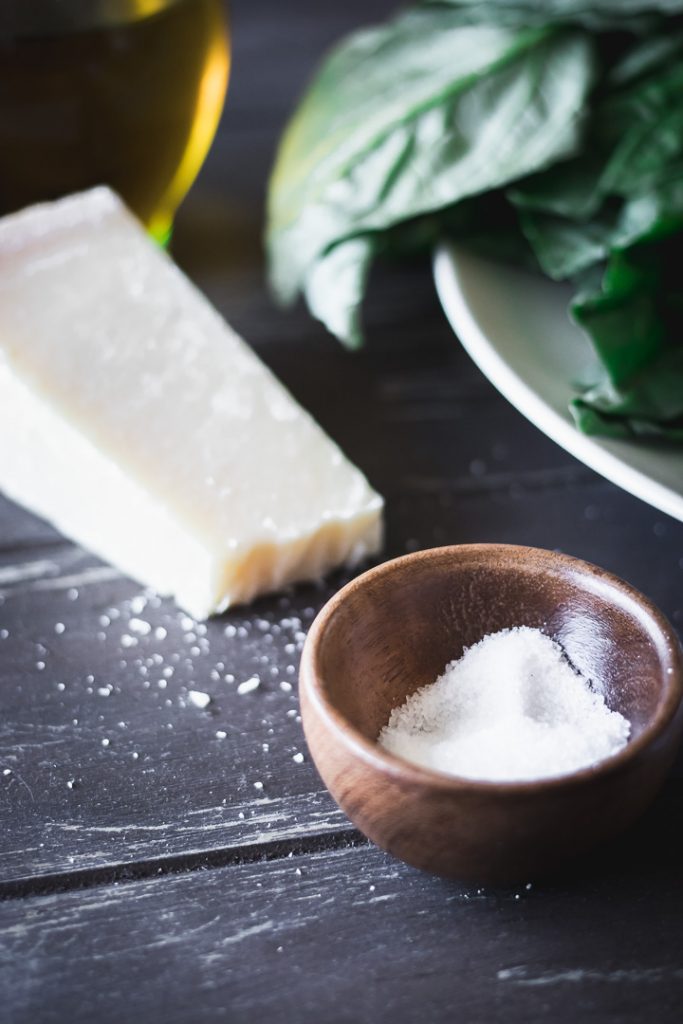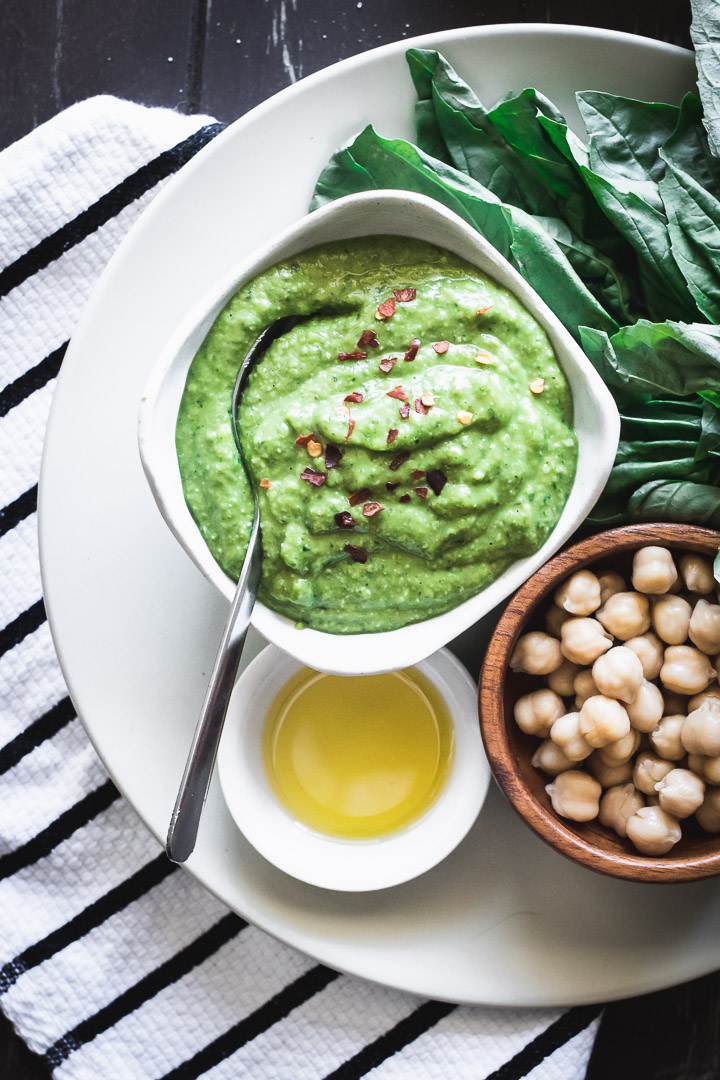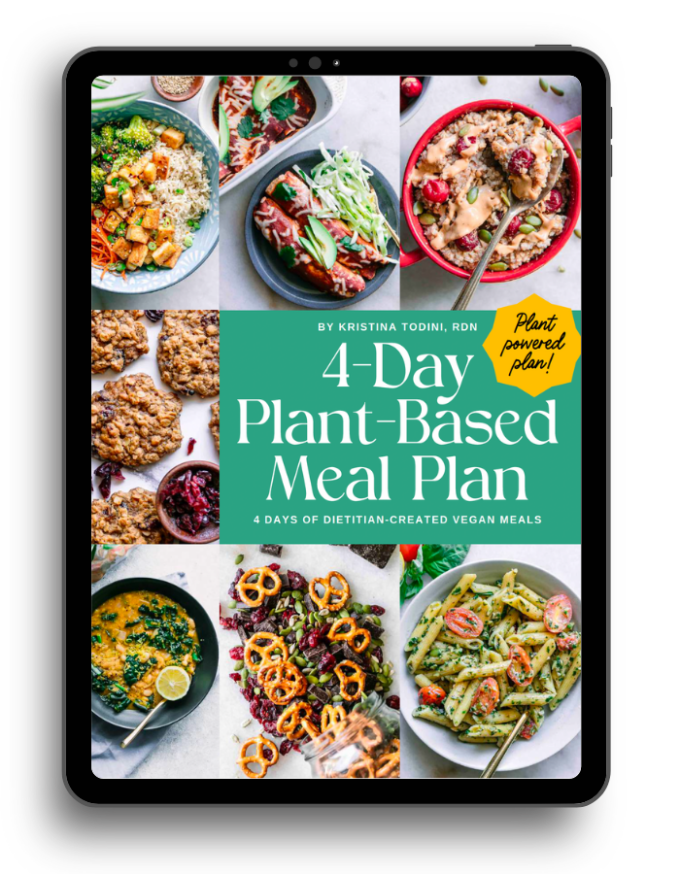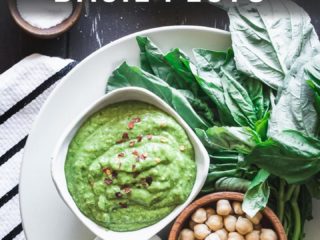Nut-Free Chickpea Basil Pesto
Nut-Free Chickpea Basil Pesto, a quick and easy pesto sauce recipe that uses garbanzo beans instead of pine nuts. This delicious recipe requires just a handful of ingredients and 5 minutes to make. Great on pasta, pizza, and veggies!

Want to Save This Recipe?
Enter your email & I’ll send it to your inbox. Plus, get new plant-based recipes in your inbox!
By submitting this form, you consent to receive emails from Fork in the Road.
Do you LOVE pesto but avoid it because of a nut allergy or sensitivity? We have a delicious Italian-inspired basil pesto recipe using chickpeas that will make you forget that traditional pesto is supposed to have nuts.
👉 Here are THREE reasons why you should be making pesto with chickpeas:
- It’s super simple. This recipe is ready-to-eat in just a few steps. You’ll add the ingredients to a food processor, pulse with some olive oil, and serve. Plus, it’s easy to store in the refrigerator or freezer so you always have some on hand for quick meals.
- It’s adjustable. Pesto is so versatile—the possibilities really are endless for what you can do with it! We love mixing in other types of greens like spinach or cilantro, or trying it with different seasonings.
- It’s tasty. Between the freshness from the basil, nutty chickpeas, and savory parmesan, this pasta sauce is absolutely delicious. You can eat it on its own or use in dishes like pasta, pizza, soups, or as a dip for vegetables.
This 5-minute, 5-ingredient Nut-Free Chickpea Basil Pesto is an easy way to still enjoy pesto without nuts or seeds. It’s delicious on pasta, pizza, and drizzled over roasted veggies. Let’s do it!
🌿 Ingredients
This nut-free pesto uses classic pesto ingredients like fresh basil, parmesan cheese, and olive oil, in addition to chickpeas instead of pine nuts. Here are the ingredients you will need:
- Basil: the key ingredient in pesto! Make sure to use fresh basil for the best results.
- Garlic, salt, and pepper: common pesto seasonings that you can adjust to your liking.
- Canned chickpeas: we made this pesto nut and seed-free by using chickpeas instead. We love using chickpeas to make pesto because they mix well and make for a thicker pesto that sticks well to pasta.
- Olive oil: boosts the flavor of pesto and contributes to its saucy texture, preventing it from becoming too thick.
- Parmesan cheese: traditionally used in pesto to bring a salty, savory flavor.
- Red pepper flakes: just a sprinkle of red pepper flakes adds a spicy kick to the recipe.
- Optional: Add a little lemon juice or zest to balance out the pesto with acid and brighten the flavor.
- Recommended tools: A food processor or blender, knife set, cutting board, and salad spinner are the main tools you will need to make chickpea pesto.

🥣 How to make (step-by-step photos)
1️⃣ Step One: Wash and prep the basil
First, clean the basil by submerging it in a large bowl of water and swishing to remove any dirt. Use a salad spinner to dry it, or lay it flat on a plate or kitchen towel.
2️⃣ Step Two: Blend the greens, chickpeas, garlic, and oil
Toss the cleaned basil in a food processor. Add chickpeas and garlic cloves, then pulse until finely chopped.
Slowly drizzle in olive oil while pulsing the ingredients. Pulse until the chopped ingredients are well coated in oil, but still chunky.
3️⃣ Step Three: Add parmesan cheese, spices, and lemon juice
Finish it off by slowly adding parmesan cheese, salt, and pepper. Mix in more seasonings to taste until you reach your perfect pesto.

❓ Recipe questions + quick tips
You can make pesto vegan and dairy-free by omitting the parmesan cheese completely, or by substituting it with nutritional yeast. Amounts may vary, but we suggest starting with 1 tablespoon and add more to your desired taste.
If you’re looking for an oil-free basil pesto recipe, then look no further. You can omit the oil in this recipe and instead use a bit of water when mixing. Keep in mind that when the pesto ingredients are blended with water then they are more likely to separate after storage, so blend again quickly before serving leftovers to ensure the ingredients are mixed well.
Pesto sauce is commonly added to pasta, pizza, soup, and sandwiches for flavor. You can also use it as a dip for vegetables, cook it into bread, or mix it with salad dressings.
While pine nuts are used in traditional pesto, there are many kinds of nuts and seeds that you can make it with. We suggest using pumpkin seeds, walnuts, cashews, pistachios, or hemp seeds if you’re looking for a replacement. You can also use chickpeas in pesto to make it completely nut-free.
🌱 Nut-free pesto variations
We are big fans of foundational recipes that can be tailored to what you have on hand, so here are a few ideas to build upon this nut-free pesto recipe and make it your own.
- Add more herbs! Use cilantro, parsley, or oregano in place of (or in addition to) basil.
- Add spices. Add cumin, red pepper, chipotle powder, or lemon basil to add a kick.
- Add citrus zest. Add a zest of lemon, lime, or even orange, as well as a bit of citrus juice.
- In place of nuts: use chickpeas, white (cannellini) beans, sunflower seeds, pumpkin seeds, hemp seeds
- Make it vegan: omit the parmesan cheese and substitute with 1-2 tablespoons of nutritional yeast

🧊 How to store
You can make a smaller amount of pesto to use all at once, or make a big batch to store and use to make quick meals. If you have extra pesto, here’s how to store it to maintain its quality:
- Refrigerator storage: 1 week in an airtight container
- Freezer: 4-6 months in a sealed freezer-safe container
👉 Pro tip: To prevent browning, it’s best to drizzle a thin layer of olive oil on the surface of pesto before putting it in the refrigerator or freezer. You can add pesto to ice cube trays, freeze, and transfer to a freezer-safe storage bag. Having small quantities on hand are perfect for when you need a quick flavor enhancer!
♻️ Sustainable kitchen tips
Making pesto from scratch is a great way to reduce food waste. Here are some suggestions to make it even more eco-friendly!
Make chickpea pesto in bulk. Prevent extra tips to the store and packaging waste by making big batches of pesto that you can freeze and use for months to come.
Repurpose chickpea cans. Rinse out the cans and keep them on hand to reuse. You can also recycle them (just don’t toss them in the trash!).
Mix in leftover greens or herbs. Spinach, parsley, cilantro, kale, collard greens—the possibilities are endless for the types of greens that you can use in pesto. Put those greens to use before they go bad!

💚 More nut-free pesto recipes
Want more pesto recipes without nuts? Pesto is a staple sauce in our kitchen, and we love testing out new variations. Here are a few of our favorites:
Looking for more pesto ideas? Try our pesto made with arugula, vegan pesto with parsley instead of basil, pesto made with kale leaves, pesto with cilantro, pesto with lemon zest, and our favorite Pesto Kale Potato Soup.

NOT SURE WHERE TO START WITH PLANT-BASED EATING?
Get my 4-Day Plant-Based Meal Plan to start your journey on the plant path.

5-Minute Nut-Free Chickpea Basil Pesto Recipe
Ingredients
- 1 cup basil
- 2 whole garlic cloves or 1 teaspoon minced ginger
- ½ cup chickpeas from about 1 15-ounce can
- ⅓ cup olive oil
- ¼ cup parmesan cheese
- ½ teaspoon red pepper flakes
- 1 pinch black pepper
- Optional: lemon zest, lemon juice to taste; salt to taste*
Instructions
- Wash and prep the basil: Start by submerging basil in a bowl of water and cleaning it off to remove any dirt. Dry it using a salad spinner or lay it flat on a plate or kitchen towel.
- Blend the greens, chickpeas, garlic, and oil: Toss the cleaned and dried basil in a food processor. Next, add chickpeas and garlic cloves. Pulse until finely chopped, slowly drizzling in olive oil until the chopped ingredients are completely covered in oil but still chunky.
- Add parmesan cheese, spices, and lemon juice: Finish by adding in parmesan cheese, salt, and pepper. Give the pesto a taste and add more seasonings until it's flavored to your liking.
Notes
- Leftovers + storage: This pesto can be stored in an airtight container in the refrigerator for 5-7 days. If ingredients start to separate, pulse in a food processor or blender to redistribute.
- Variations: Make it vegan by omitting the the parmesan cheese and substitute with 1-2 tablespoons of nutritional yeast. Make it oil-free by mixing with water. Experiment with different nut-free basil pestos by using white beans or, if you can eat seeds, sunflower or squash seeds.
- Nutrition notes: This recipe is a great source of calcium, a good source of vitamin A, and is full of protein with the addition of chickpeas. A great nutrition addition to your next pasta or pizza recipe.
- *This recipe does not include additional salt because the parmesan cheese is very salt already. However, when taste testing add a small amount if needed to fit your desired flavor.
Nutrition
UPDATE: This recipe was originally published in March 2018 and updated for clarity in October 2021.


I love pesto but I do not love nuts in my pesto. I absolutely love the idea of adding chickpea to pesto. It is a great flavor enhancer and thickener. Love the variations to the recipe! So versatile.
I like the idea of using chickpeas in pesto in place of the nuts. I don’t have any problems with any of the traditional ingredients, but sometimes it is interesting to mix it up.
Very interesting texture, would like to taste this pesto, since I love chickpeas. It is good to know that people with allergies can enjoy it.
Fabulous recipe! I bet it would be great on pasta, fish or steak too! I love the variations you provided too…thanks!
I can vouch and say it is delicious on all three! Pesto pasta AND pesto pizza recipe coming soon. 😉
This is such a clever idea! I’ll have to pass it along to some of my friends with kids who have nut allergies.
It took a lot of experimenting but this is one of my favorite variations of nut-free pesto. It’s possible to still enjoy it!
I really like that you give so many options to make this recipe your own! Your pesto looks so much like a traditional pesto. I find pine nuts to be difficult to digest so this is a great alternative for me!
Yes, I’m all about variation. I am always experimenting with new flavors and takes on my favorite foundational recipes.
I LOVE pesto and have no allergies, but also really enjoy whipping up alternative pestos with different flavors. I think it’s awesome this one is made with chickpeas and I definitely want to try it!!
It’s delicious and the chickpeas give it a thicker texture, which sticks well to pastas and pizzas. Thanks for stopping by!
I saw your recipe somewhere else and at the time thought that I couldn’t wait to give it a try. The addition of chickpea is so unusual and the result looks amazing! Yum!
That’s great to hear! I hope it helps inspire people with food allergies to experiment with different food and flavors in place of nuts or other allergens.
I love that you switched it up with the chickpeas! I can already think of so many recipes that this would be delicious in!
Yes, I’ve been using it on pastas, pizzas, and drizzled over veggies and meats. Delish!
This is such a brilliant swap! My son goes to a nut-free preschool and I have about 10 pounds of garlic scape pesto in the freezer I can’t use because then he can’t take leftovers for lunch. I can’t wait to give this a try; he loves chickpeas!
The good thing is that it’s full of fiber from the chickpeas…but you don’t even need to tell anyone about them. Sneak a little nutrition in where you can.
This looks yummy! I love chickpeas!
Great! I love them too and I especially like the texture they give this pesto. Let me know if you try the recipe, thank you for stoping by!
The recipe just says chick peas. Are they raw or cooked?
Many thanks
They are cooked, or from the can and drained. Thanks for pointing that, I updated the instructions. Please let me know how it turns out!
Is it possible to freeze the leftover Pesto?
Hi Joan, thanks for your question. Yes, pesto freezes well and there are many ways you can go about it. You can freeze it in an airtight jar or container, pour it into a plastic bag and lay flat in freezer (takes up less space and then just pull it out and thaw when needed). Or, my favorite way, pour the pesto into ice cube trays and then freeze the pesto cubes and drop them into soups or pastas when cooking. Easy!
I like the idea of using chickpeas instead of nuts in the pesto! I’m a college student and to say the least nuts (like pine nuts and walnuts) aren’t very cheep. Chickpeas sound like the perfect, economic substitution 🙂
I’m glad you think so! For me it was a matter of having to avoid pesto and other sauces with nuts because of a food sensitivity, so I started substituting other things like sunflower seeds and beans. Chickpeas has been my favorite substitute so far because they give it a nutty texture, but they’re also much cheaper than nuts as well (and still provide good protein). Let me know if you make the recipe!
This is delicious! A great pesto for those with tree nut allergies. In fact, it’s just plain good for anyone.
I’m so glad you liked it! I had been avoiding nuts for so long before I started experimenting with different nut-free pestos and this one is definitely my favorite. Thanks for leaving your review!
Thank you for the information. I just want to figure out if chickpea can be a substitute to nuts and sure indeed. ?. Thanks for your website.
Thanks for leaving me a note! Yes, they can be substituted. Obviously they will have a slightly different texture, but the point of them is to add some consistency to the pesto and they definitely do the trick. I hope you enjoy!
Hands down delicious-no one will guess there are chick peas in lieu of nuts, there is a bit of crunch.
That’s great, Janice! I’m so glad you enjoyed it, I struggled with not being able to eat pestos and once I started making my own with chickpeas I was so happy to be able to enjoy pesto pastas and pizzas again. Enjoy!
Hi Kristina,
Great idea ?
I have five good sized basil bushes so will be making a large amount!
Can I freeze this ?
Bon soirée x
Hi Wendy! Yes, pesto freezes well and there are many ways you can go about it. You can freeze it in an airtight jar or container, pour it into a plastic bag and lay flat in freezer (takes up less space and then just pull it out and thaw when needed). Or, my favorite way, pour the pesto into ice cube trays and then freeze the pesto cubes and drop them into soups or pastas when cooking. Easy!